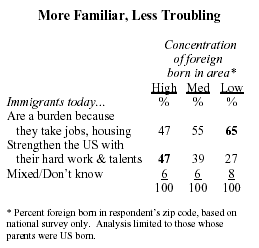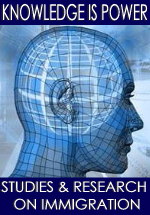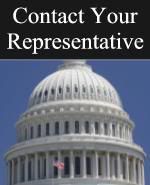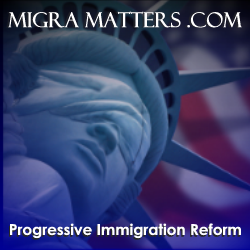Anatomy of a wedge issue: immigration
In order to truly understand all the nuances and complexities of the current immigration debate it would seem that one would need to have a working knowledge of the current immigration laws, the economic ramifications of immigration both legal and illegal, and be familiar with the foreign policy and trade agreements that effect the countries of origin of the current crop of undocumented immigrants.
Or maybe you would just have to understand how Republicans play political hardball, how the Rovian reptilian mind works and to what extremes they are willing go to stay in power.
On November 3, 2004 , the day after eleven states had run referendums on their ballots to ban gay marriage, the right-wing powers that be must have felt pretty good about themselves. They had successfully taken what should have been a non-issue, and turned it into a referendum on "moral decay", "family values" and the "destruction of the family". They had fabricated an issue they could put before close to one fifth the electorate and be assured it would bring out an army of the faithful to pull the lever for a Republican candidate who would protect them from those pushing "the gay agenda" and ruining America with their "out of touch", liberal, Hollywood ideology.
The pundits analyzed the election ad nauseam and for weeks all we heard about were "values voters" and how liberals just didn't "get it". It was a diabolically brilliant plan. For many there was no need to debate about war, a failing economy, deficits, Presidential lies or overreach, no reason to talk about missing WMDs, or insurgencies; instead, it was an election about whether two people of the same sex should be afforded the right to marry.
The plan did what it was supposed to do… it brought out the "base." The Republicans had pulled off a cheap magician's parlor trick and misdirected many from the important issues and instead had them concentrate on something that for the most part had no effect on their daily lives.
Now though, the Republicans were faced with a problem. What could possibly be the follow-up to such a successful act, how could they craft a sequel to top it? They had already played the fear card with their "keeping you safe from terrorism" and "everything changed on 9-11" rhetoric, and now the "values" card had been played also. It looked like the Republican deck was getting slim. But, au contraire…when all else fails in the Republican playbook …the answer is to return to your roots and go back to the tried and true, the one thing that always works….Willie Horton….or in this case Juan Hortona.
(more below the fold)
tags: immigration, Republicans, wedge issue, HR 4437
The answer they came up with was the not so subtle mix of race, fear, xenophobic populism and the backlash to a bad economy and globalization that now constitutes "The immigration debate". They would put together a coalition of old school racists, economically marginalized middle and working-class Americans who have been left behind in the new "flat world" economy of outsourcing and globalization, those most effected by the destruction of the US manufacturing base and those who have suffered most from the conservatives conscious effort to shift wealth from the middle to upper classes and present them with a new enemy on which to channel their discontent. In other words a classic wedge issue.
Who's behind the immigration issue
To understand the way this plan is now playing out one need only take a quick look at two recently released studies that show how this dynamic is playing out and just how those least effected by the "broken borders" and increased flow of undocumented immigrants are the very people leading the charge to close them.
A new analysis of Congressional voting patterns by The American Immigration Law Foundation shows that those representing districts least likely affected by the influx of undocumented immigrants are the first to champion restrictive immigration policies.
An analysis of the Congressional representatives who supported the draconian House enforcement only bill,HR 4437 reveals that those representing districts with the fewest number undocumented immigrants generally supported the restrictive immigration plan, while those with large numbers of undocumented immigrants in their districts were more apt to oppose it.
Representatives From Districts With Fewer Than 5,000 Undocumented Immigrants Were Most Likely To Support The Bill
There are 96 congressional districts that have fewer than 5,000 undocumented immigrants. Most of these districts are largely rural and located in sections of Appalachia, the Midwest, and the Mississippi Valley that are experiencing little economic growth and low levels of immigration in general. Constituents in many of these districts face tough economic times, but the cause is not immigration. Immigrants are attracted to regions of economic dynamism and job expansion. This is why greater numbers of undocumented immigrants are found in western states that have agricultural, livestock, fishing, and tourist economies that need the kinds of less-skilled labor that undocumented immigrants often provide.
Undocumented immigrants in the 96 lowest-immigration districts make up no more than 0.8 percent of the population (each of the 435 congressional districts has roughly the same total population: about 650,000 as of 20001). The votes on H.R. 4437 in these districts tell you something about immigration politics in the United States today. The supposed threat from undocumented immigration is enough to rally voters and move levers of power even in areas where the actual impact is miniscule. Among representatives from districts with the smallest populations of undocumented immigrants, 74 percent (71 out of 96) voted for the bill: 90 percent of Republicans (56 out of 62) and 44 percent of Democrats (15 out of 34)
Representatives From Districts With More Than 50,000 Undocumented Immigrants Were Most Likely To Oppose The Bill
The voting pattern of the representatives from the 61 congressional districts with 50,000 or more undocumented immigrants tells a different story. These districts for the most part are located in densely populated urban areas such as New York City, Chicago, and Los Angeles, and are relatively small in geographic size compared to rural districts that include many counties. In these high-immigration districts, the undocumented alone can account for as much as one-fifth of the total population. As a result, representatives who hail from these areas are familiar with undocumented immigrants and their impact on local communities. Among representatives from districts with the largest populations of undocumented immigrants, a mere 5 percent (3 out of 61) supported the bill: none of the 53 Democrats and only 3 of the 8 Republicans.
The inverse relationship between support for H.R. 4437 and the actual presence of undocumented immigrants in a representative’s district represents a widespread voting pattern. Among all Democrats, those who voted in favor of the bill had roughly 10,000 undocumented immigrants in their districts. Democrats who opposed the bill, on the other hand, had about 37,400. Among all Republicans, the same pattern holds: those voting for H.R. 4437 had an average of 14,500 undocumented immigrants in their districts, while those who voted against the bill had an average of 30,800
Overall 67% of all those who supported the bill from both parties came from districts with fewer than 15,000 undocumented immigrants while 62% of those opposed came from districts with more than 15,000.
Voters proximity to immigrants effects perceptions and attitudes
A new report released last week by the Pew Research Center entitled "America's Immigration Quandary" reveals what common sense would lead us to assume: Those with the least contact with immigrants have the most negative opinions about them and feel they are a threat to the American way of life. The survey was taken during the period February 8 – March 7, 2006, prior to the current heating up of the issue due to increased media attention.
The survey finds a complex relationship between exposure to immigrants and opinions about them and the immigration problem, more generally. People who live in areas that have high concentrations of immigrants are less likely to see them as a burden to society and a threat to traditional American customs and values. However, they are more apt than others to see immigration as an important problem for their local community.
In sharp contrast, native-born Americans who live in areas with few immigrants understandably are less inclined to see immigration as a local problem. However, many more of those in areas with relatively low concentrations of foreign-born people see immigrants as a burden to the nation and as a threat to American customs. People living in areas with few immigrants have a considerably more negative opinion of Hispanics and a slightly more negative view of Asians.
-snip-
Moreover, native-born Americans who live in areas with the highest concentration of immigrants hold more positive opinions of them. Analysis of the survey indicates that their more favorable views do not merely reflect their demographics or political composition, but suggests that exposure to and experience with immigrants results in a better impression of them. However, Americans living in areas with more immigrants rank immigration as a bigger community problem.
And while there is concern about the impact of immigration on the availability of jobs, nearly two-thirds (65%) say that immigrants coming to the country mostly take jobs that Americans do not want, rather than take jobs away from Americans. In this regard, the recent influx of immigrants into such metropolitan areas as Phoenix, Las Vegas and Raleigh-Durham has not undermined the generally positive perceptions residents have of the local job market.

The most telling statistic was how important most Americans viewed the issue. While 21% said immigration had an effect on their community only 4% viewed it as a major problem facing the country.
In general, however, the issue of immigration is not a top-tier problem for most Americans. Just 4% volunteer it as the most important problem facing the country, far fewer than the number mentioning the war in Iraq, dissatisfaction with the government, terrorism, and several other issues
What we appear to have with the "immigration debate" is an issue that most Americans don't find very important, being moved to the front of the political agenda by politicians from areas least effected by immigrants and representing a constituency that although they have little practical reason for concern, feel that immigrants somehow threaten their way of life. Or as we like to say a classic Republican wedge issue of misdirection.
The BIG picture, we're all being played
There are many who will offer up anecdotal evidence about their cousin who lost his job hanging drywall at $20 an hour because immigrants work far cheaper, or their brother who can't find an IT job because the market is flooded with foreigners with H-1b visas. I would not argue that in some cases the failures of US immigration policy have had an adverse effect on some sectors of the native workforce, particularly those from the most vulnerable segments of the population, those with the lowest educational levels, from minority communities and from in areas of economic depression due to the loss of manufacturing jobs. Others will tell stories of how they waited in a hospital emergency room for hours when their child broke a finger at a softball game because the staff was overwhelmed with a mass of humanity looking for treatment common illnesses. Again I won't argue.. the healthcare system in this nation is a mess and yes undocumented immigrants only add to the 45 mil uninsured Americans who are forced to use our nations emergency rooms as their primary source of medical care.
But … I would put forward this test for all those who the favor the "tough" approach to immigration reform favored by Tom Tancredo and Jim Sensenbrenner …. If all the undocumented immigrants in the nation were to leave tomorrow, all 12 million of them, would this solve ANY of this nations most basic economic and social problems.
WOULD IT FIX ALL THE DAMAGED REPUBLICAN CONTROL HAS WROUGHT ON MIDDLE AND WORKING CLASS AMERICANS?.....of course not.
That in essence is the whole point of the immigration issue… to keep the American people fighting against imaginary adversaries in order that they don't start to address the real problems that effect them …Literally the elephants in the room.

































2 comments:
Great diary, Duke. I'm glad it got a lot of attention at DKos and BooTrib.
thanks to meteor blades...he rescued it at the last minute at Kos before it fell off the board..he posted up a pimp diary and within minutes it was on the rec list.. I owe him a big thanks.
Post a Comment